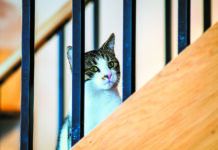[From Tufts March 2011 Issue]
Ever puzzled by what your cat is trying to tell you? Or wonder what her mood is? One way to communicate better with our cats is by learning how to interpret their body postures — especially the tail position.
The versatile tail definitely does more than provide balance or act as a rudder for swim-minded cats. Cats use their tails to signal their moods. Recognizing the messages delivered in tail talk can help you better communicate with your cat. Here are some key tail positions and what they mean, as identified by Patrick Melese, DVM, a veterinarian who is board-certified in animal behavior, and Alice Moon-Fanelli, PhD, a certified-applied animal behaviorist who consults for Catnip.
Hoisted high. A confident, contented cat will hold her tail high in the air as she moves about the house. A tail that is erect like a flagpole signals a happy mood or a friendly greeting. .
Question mark. A tail looking bent in a question mark often conveys a playful mood. This would be a good time to engage in a 5- or 10-minute play session with your cat.
Flying low. A tail positioned straight down, parallel to the legs, may represent an aggressive mood. Be wary. However, there are exceptions to this rule. Some breeds, such as Persians, Exotics and Scottish Folds, normally tend to carry their tails lower than their backs.
Tucked away. A tail curved beneath the body signals fear or submission. Something is making the cat feel nervous.
Puffed up. A tail that spreads out like a pipe cleaner indicates that the cat is severely agitated or frightened. This tail posture is designed to make the cat look bigger to ward off danger.
Whipping. A tail that whips rapidly back and forth indicates both fear and aggression. It is a warning that says, “back off.”
Wishing. A tail that swishes slowly from side to side usually means that the cat is focused on an object. Cats often swish their tails right before they pounce on a toy mouse. It is part of their predatory positioning.
Twitching. A tail that twitches just at the tip is a sign of curiosity and excitement.
Cat-to-cat tail touching. A tail wrapped around another cat is equivalent to a person casually putting her arm around a favorite pal. It conveys feline friendship. My cats, Murphy and Zeki, often stroll down the hallway with their tails touching.



